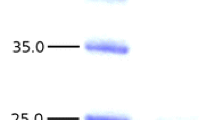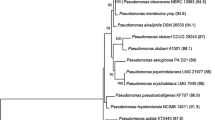Abstract
The aim of this study was to characterize a facultative chemolithotrophic arsenite-oxidizing bacterium by evaluating the growth and the rate of arsenite oxidation and to investigate the genetic determinants for arsenic resistance and CO2 fixation. The strain under study, Ancylobacter dichloromethanicus As3-1b, in a minimal medium containing 3 mM of arsenite as electron donor and 6 mM of CO2–bicarbonate as the C source, has a doubling time (td) of 8.1 h. Growth and arsenite oxidation were significantly enhanced by the presence of 0.01 % yeast extract, decreasing the t d to 4.3 h. The strain carried arsenite oxidase (aioA) gene highly similar to those of previously reported arsenite-oxidizing Alpha-proteobacteria. The RuBisCO Type-I (cbbL) gene was amplified and sequenced too, underscoring the ability of As3-1b to carry out autotrophic As(III) oxidation. The results suggest that A. dichloromethanicus As3-1b can be a good candidate for the oxidation of arsenite in polluted waters or groundwaters.


Similar content being viewed by others
References
Alfreider A, Vogt C, Hoffmann D, Babe W (2003) Diversity of ribulose-1,5-bisphosphate carboxylase/oxygenase large-subunit genes from groundwater and aquifer microorganisms. Microb Ecol 45:317–328
Alfreider A, Vog C, Geiger-Kaiser M, Psenner R (2009) Distribution and diversity of autotrophic bacteria in groundwater systems based on the analysis of RuBisCO genotypes. Syst Appl Microbiol 32:140–150
Anderson GL, Love M, Zeider BK (2003) Metabolic energy from arsenite oxidation in Alcaligenes faecalis. J Phys IV France 107:49–52
Bryan CG, Marchal M, Battaglia-Brunet F, Kugler V, Lemaitre-Guiller C, Lièvremont D, Bertin PN, Arsène-Ploetze F (2009) Carbon and arsenic metabolism in Thiomonas strains: differences revealed diverse adaptation processes. BMC Microbiol 9:127–138
Cai L, Guanghui L, Rensing C, Wang G (2009) Genes involved in arsenic transformation and resistance associated with different levels of arsenic-contaminated soils. BMC Microbiol 9:4–14
Cavalca L, Zanchi R, Corsini A, Colombo M, Romagnoli C, Canzi E, Andreoni V (2010) Arsenic-resistant bacteria associated with roots of the wild Cirsium arvense (L) plant from an arsenic polluted soil, and screening of potential plant growth-promoting characteristics. Syst Appl Microbiol 33:154–164
Dhar RK, Zheng Y, Rubenstone J, van Geen A (2004) A rapid colorimetric method for measuring arsenic concentrations in groundwater. Anal Chim Acta 526:203–209
Donahoe-Christiansen J, D’Imperio S, Jackson CR, Inskeep WP, McDermott TR (2004) Arsenite-oxidizing Hydrogenobaculum strain isolated from an acid-sulfate-chloride geothermal spring in Yellowstone National Park. Appl Environ Microbiol 70:1865–1868
Duquesne K, Lieutaud A, Ratouchniak J, Muller D, Lett MC, Bonnefoy V (2008) Arsenite oxidation by a chemoautotrophic moderately acidophilic Thiomonas sp.: from the strain isolation to the gene study. Environ Microbiol 10:228–237
Garcia-Dominguez E, Mumford A, Rhine ED, Paschal A, Young LY (2008) Novel autotrophic arsenite-oxidizing bacteria isolated from soil and sediments. FEMS Microbiol Ecol 66:401–410
Gihring TM, Druschel GK, McCleskey RB, Hamers MJ, Banfield JF (2001) Rapid arsenite oxidation by Thermus aquaticus and Thermus thermophilus: field and laboratory investigations. Environ Sci Technol 35:3857–3862
Hoeft SE, Blum JS, Stoltz JF, Tabita FR, Witte B, King GM, Santini JM, Ormeland RS (2007) Alkalilimnicola ehrlichii sp. nov., a novel, arsenite-oxidizing haloalkaliphilic gammaproteobacterium capable of chemoautotrophic or heterotrophic growth with nitrate or oxygen as the electron acceptor. Int J Syst Evol Microbiol 57:504–512
Heinrich-Salmeron A, Cordi A, Brochier-Armanet C, Halter D, Pagnout C, Abbaszadeh-fard E, Montaut D, Seby F, Bertin PN, Bauda P, Arsène-Ploetze F (2011) Unsuspected diversity of arsenite-oxidizing bacteria revealed 1 by a widespread 2 distribution of the aoxB gene in prokaryotes. Appl Environ Microbiol 77:4685–4692
Inskeep WP, Macur RE, Hamamura N, Warelow TP, Ward SA, Santini JM (2007) Detection, diversity and expression of aerobic bacterial arsenite oxidase genes. Environ Microbiol 9:934–943
Kashyap DR, Botero LM, Franck WL, Hassett DJ, McDermott TR (2006) Complex regulation of arsenite oxidation in Agrobacterium tumefaciens. J Bacteriol 188:1081–1088
Kepner RL, Pratt R (1994) Use of fluorochromes for direct enumeration of total bacteria in environmental samples: past and present. Microbiol Rev 58:603–615
Lett MC, Muller D, Lièvremont D, Silver S, Santini J (2012) Unified nomenclature for genes involved in prokaryotic aerobic arsenite oxidation. J Bacteriol 194:207–208
Lugtu RT, Choi SC, Oh YS (2009) Arsenite oxidation by a facultative chemolithotrophic bacterium SDB1 isolated from mine tailing. J Microbiol 47:686–692
Muller D, Lièvremont D, Simeonova DD, Hubert JC, Lett MC (2003) Arsenite oxidase aox genes from a metal-resistant β-Proteobacterium. J Bacteriol 185:135–141
Oremland RS, Hoeft SE, Santini JM, Bano N, Hollibaugh RA, Hollibaugh JT (2002) Anaerobic oxidation of arsenite in Mono Lake water and by a facultative, arsenite–oxidizing chemoautotroph, strain MLHE-1. Appl Environ Microbiol 68:4802–4975
Osborne TH, Jamieson HE, Hudson-Edwards KA, Nordstrom DK, Walker SW, Ward SA, Santini JM (2010) Microbial oxidation of arsenite in a subarctic environment: diversity of arsenite oxidase genes and identification of a psychrotolerant arsenite oxidiser. BMC Microbiol 10:205–212
Quéméneur M, Heinrich-Salmeron A, Muller D, Lièvremont D, Jauzein M, Bertin PN, Garrido F, Joulian C (2008) Diversity surveys and evolutionary relationships of aoxB genes in aerobic arsenite-oxidizing bacteria. Appl Environ Microbiol 74:4567–4573
Qin J, Rosen BP, Zhang Y, Wang G, Franke S, Rensing C (2006) Arsenic detoxification and evolution of trimethylarsine gas by a microbial arsenite-S-adenosylmethionine methyltransferase. Proc Natl Acad Sci USA 103:2075–2080
Rhine ED, Chadhain SMN, Zylstra GJ, Young LY (2007) The arsenite oxidase genes (aroAB) in novel chemoautotrophic arsenite oxidizers. Biochem Biophys Res Comm 354:662–667
Santini JM, Sly LI, Schnagl RD, Macy JM (2000) A new chemolithoautotrophic arsenite-oxidizing bacterium isolated from a gold mine : phylogenetic, physiological, and preliminary biochemical studies. Appl Environ Microbiol 66:92–97
Santini JM, vanden Hoven RN (2004) Molybdenum containing arsenite oxidase of the chemolithoautotrophic arsenite-oxidizer NT-26. J Bacteriol 186:1614–1619
Silver S, Phung LT (2005) Genes and enzymes involved in bacterial oxidation and reduction of inorganic arsenic. Appl Environ Microbiol 71:599–608
Stolz JF, Basu P, Santini JM, Oremland RS (2006) Arsenic and selenium in microbial metabolism. Annu Rev Microbiol 60:107–130
Tabita RF, Hanson ET, Li H, Satagopan SL, Sing J, Chan S (2007) Function, structure, and evolution of the RuBisCO-like proteins and their RuBisCO homologs. Microbiol Mol Biol Rev 71:576–599
Tamura K, Dudley J, Nei M, Kumar S (2007) MEGA4: molecular evolutionary genetics analysis (MEGA) software version 4.0. Mol Biol Evol 24:1596–1599
Tourova TP, Kovaleva OL, Sorokin DY, Muyzer G (2010) Ribulose-1,5-bisphosphate carboxylase/oxygenase genes as a functional marker for chemolithoautotrophic halophilic sulfur-oxidizing bacteria in hypersaline habitats. Microbiology 156:2016–2025
Watson GMF, Tabita FR (1997) Microbial ribulose 1,5-bisphosphate carboxylase/oxygenase: a molecule for phylogenetic and enzymological investigation. FEMS Microbiol Lett 146:13–22
Acknowledgments
The research was supported by 2008 MIUR1225195005-60 of Italian Ministry for University and Research, Rome, Italy.
Author information
Authors and Affiliations
Corresponding author
Electronic supplementary material
Below is the link to the electronic supplementary material.
Rights and permissions
About this article
Cite this article
Andreoni, V., Zanchi, R., Cavalca, L. et al. Arsenite Oxidation in Ancylobacter dichloromethanicus As3-1b Strain: Detection of Genes Involved in Arsenite Oxidation and CO2 Fixation. Curr Microbiol 65, 212–218 (2012). https://doi.org/10.1007/s00284-012-0149-9
Received:
Accepted:
Published:
Issue Date:
DOI: https://doi.org/10.1007/s00284-012-0149-9




